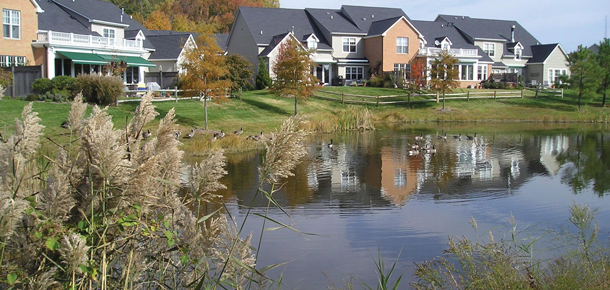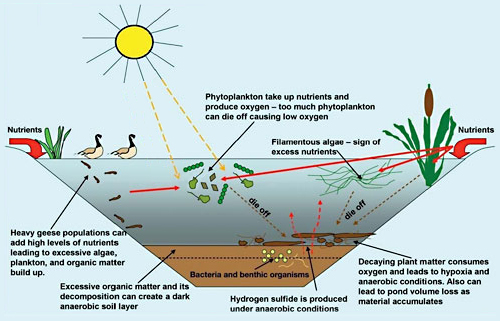Knauss legislative fellowships in Congress help build careers — and they're fun and educational. See our video and fact sheet for details.
Pond Management

Travel to any housing development or suburban community in Maryland, and you’ll likely find a bowl-shaped pond or two. Maryland has thousands of stormwater ponds covering hundreds of thousands of acres.
Stormwater ponds play an important role in controlling pollution in the Chesapeake Bay. Helping homeowners to keep them working properly is a priority of Maryland Sea Grant's.
Ponds store water when it rains. Because of land development like buildings and parking lots, much of the water that falls in Maryland during a big rain storm can’t be absorbed by the soil. Instead, it runs off pavement into local streams and, eventually, the Bay. Along the way, the storm water picks up excess nutrients, like nitrogen and phosphorus, and other pollutants that could harm the Bay's water quality. Flowers, grasses, and shrubs planted along the edge of stormwater ponds can take up some of the excess nutrients before they enter ponds or the Bay.
Many Maryland homeowners also enjoy ornamental ponds in their yards. But if not controlled, excess nutrients in stormwater and ornamental ponds can cause blooms of algae that in turn create unsightly green scum and foul odors.
How Maryland Sea Grant Extension Can Help
- Check out our 10-page fact sheet, Urban and Stormwater Pond Management.
- See our guide to native plants suitable for use in stormwater ponds, Plants Recommended for Stormwater Ponds.
- Our Extension specialists offer workshops and training programs to educate communities about maintaining healthy ponds.
- We provide tips on species selection and planting that will result in reduced nitrogen and phosphorus in ponds.
- We offer workshops for natural resource agencies, pond and housing development contractors, and pond owners.
- We provide update workshops for licensed commercial Pesticide Applicators in Category V – Aquatic for their annual mandated training.
Improve Your Stormwater Pond
You can take a number of basic steps to improve a pond near you:
- Plant densely: To limit sediment runoff and reduce weed seed germination, same-plant species should be grouped together to help provide dense growth.
- Limit lawn fertilizers: The nutrients contained in many turf grass fertilizers are one of the prime threats to the health of vegetation planted in stormwater ponds across Maryland. Encourage your community to use fertilizers sparingly or to switch to organic and low-phosphorus products.
- Connect with others: Find out about designing and maintaining stormwater ponds from the Chesapeake Stormwater Network.
Benefits of Stormwater Ponds
Besides their role in improving water quality, a well-managed stormwater pond can be an asset for a community in other ways:
- Stormwater ponds can provide habitat for the state’s wetland plant species whose ranges have been cut drastically by development.
- Healthy stormwater ponds support diverse populations of wildlife, including birds, fish, frogs, and turtles.
- An aesthetically pleasing stormwater pond can provide a recreational space for community members to walk, bike, or just sit and read.
Challenges Facing the Use of Stormwater Ponds
Communities around Maryland face a number of challenges in maintaining the aesthetics and water quality of their stormwater ponds:
- The overuse of lawn fertilizers in the surrounding community can encourage harmful and unsightly blooms of algae.
- Water birds like ducks and geese can transport unwanted plant and algae species to stormwater ponds. Their waste also adds another source of excess nutrients to these aquatic habitats.
- Ponds that fill in with marsh plant species, such as Phragmites reeds or cattails, will lose their capacity to hold water.
- See a graphic (below) illustrating an unhealthy stormwater pond.

Testing Other Methods
We work with partners to design and test tools for controlling algae growth in water bodies. For example:
- Barley straw: Ordinary barley straw contains a molecule that can slow the growth of some freshwater algae. We’ve explored using this agricultural product as an alternative to pesticides in controlling algae blooms. Read more about this in our fact sheet, Barley Straw: A Potential Method of Algae Control in Ponds.
- Algae turf scrubbers: These systems use species of large, rather than microscopic, algae (also known as seaweeds) to absorb nutrients from aquatic environments. To learn more about this new technology, read “River of Opportunity: Innovation for a Cleaner Chesapeake,” an article in Chesapeake Quarterly, Maryland Sea Grant’s magazine.
Maryland Sea Grant Extension Personnel

Water Quality Specialist - Principal Agent
Phone: (301) 789-5256
Email: lazur@umd.edu



